GREAT YARMOUTH HERRING INDUSTRY
& THE RAILWAYS
[Source: Darren Kitson]
Many animal species migrate, often to follow food sources, according to season and fish are no exception. In the North Sea off the coast of Norfolk lies an area of sandbanks, the best known of these perhaps being Haisborough Bank ('Haisborough' is the pronunciation of the Norfolk coastal village and parish of Happisburgh). On the eastern edge of this area of sandbanks lies Smith's Knoll, once the location of a lightship, some 25 miles off the Norfolk coast and it was to here that during September and October each year the Great Yarmouth herring fleet set sail. This does not, however, mean that fishing fleets were idle for the remainder of the year. Fishermen followed the shoals and his is the reason why, for example, vessels from East Anglian ports could be seen as far away as locations such as Padstow. Nevertheless, we are concerned here only with Great Yarmouth and the catches landed there. Herring are a species of the Clupeidae family, found in a number of seas and oceans the most common is the Atlantic Herring with habitat being shallow, temperate waters. An oily fish, herring are most commonly served pickled or smoked of which the latter, when split open 'butterfly' fashion, is a kipper.
The Great Yarmouth fishing industry had been active for centuries and there was great always rivalry with nearby Lowestoft. A major problem, as with many other foods but with fish in particular, was how quickly it began to rot after being caught. Ice houses helped but it was not until the coming of the railways that catches could be distributed to markets far away. Fish traffic was just one of many seasonal traffic flows handled by the railways, another well known seasonal commodity being sugar beet, none of which were hugely profitable and indeed tended to be an operating nuisance but were nevertheless business which for many decades only the railways could handle. The handling of fish traffic was, in part due to its seasonal nature, extremely complicated. In September 1951 British Railways issued Circular No.F.192.E detailing working timetables, operating procedures and so on for the ‘East Anglian Herring Season 1951’. It is a lengthy and complex document impractical to reproduce in full here so what follows is a few selected descriptions concerning mainly Great Yarmouth South Town (although all three of Yarmouth's main stations handled fish traffic with Beach handling a not inconsiderable amount, considering the M&GN route was plagued by being largely single track).
A train departed South Town at 3.5pm for Swindon Marston Sidings and operated via Cambridge and Oxford with the London Midland Region taking over at Cambridge. Fish on this train was destined for Oxford and stations north, Swindon, South Wales and the West of England. It was a 'passenger-rated' train, meaning not that it also conveyed passengers but that it ran at passenger train speeds. Wagons and vans were thus XP rated and this usually meant a maximum speed of 60mph - hardly fast by today's standards but faster than with non XP rated stock. The 3.5pm joined with the 3.10pm from Lowestoft at Haddiscoe LL and involved a propelling move, for the Yarmouth portion, along the chord from Fleet Jct. to Haddiscoe LL from which the combined ensemble departed at 3.44pm. The route thence to Cambridge was via Thetford and Ely. Arrival at Cambridge (station) was 6.42pm and at Trumpington Sidings (located at Long Road, just south of Cambridge station) 6.45pm. There was a thirty minute wait at Trumpington, where the LMR took over, with arrival at Swindon eventually occurrng at 12.5am.
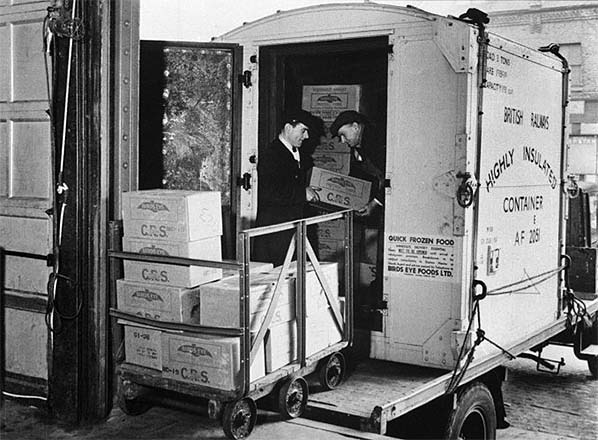 A British Railways 'Highly Insulated Container' being [presumably] loaded with Birds Eye products while mounted on a flatbed lorry. The photograph was taken by the British Transport Commission and is now in the collection of the National Railway Museum (NRM). Whilst we must be grateful for the survival of such photographs, unfortunately information provided with them by the NRM sparse. Therefore where and when this photograph was taken remains a mystery. Perhaps somebody will recognise the location from the building in the right background. Whatever and whenever, this view is included to provide a close-up view of an insulated Door-to-Door type container and the relatively cumbersome manual loading method in use at the time. The boxes are marked both Birds Eye and CRS, suggesting that the latter had a contract with Birds Eye or, perhaps, supplied the packaging. CRS provide cold storage solutions and are still in business today. A British Railways 'Highly Insulated Container' being [presumably] loaded with Birds Eye products while mounted on a flatbed lorry. The photograph was taken by the British Transport Commission and is now in the collection of the National Railway Museum (NRM). Whilst we must be grateful for the survival of such photographs, unfortunately information provided with them by the NRM sparse. Therefore where and when this photograph was taken remains a mystery. Perhaps somebody will recognise the location from the building in the right background. Whatever and whenever, this view is included to provide a close-up view of an insulated Door-to-Door type container and the relatively cumbersome manual loading method in use at the time. The boxes are marked both Birds Eye and CRS, suggesting that the latter had a contract with Birds Eye or, perhaps, supplied the packaging. CRS provide cold storage solutions and are still in business today.
Photo © National Railway Museum/SSPL and reproduced under Creative Commons Licence
Another passenger-rated train departed South Town at 4.0pm. At Beccles this train combined with another from Lowestoft Central. This train, irrespective of origin, conveyed traffic for Liverpool Street, the Southern Region and Western Region stations short of Swindon (meaning stations between Swindon and Paddington). At Beccles special instructions applied, namely that Beccles Bank box was to remain open for the passage of this train and when necessary the train was to be assisted from the rear between Beccles and Beccles Bank box. In addition, the combined train was to be worked forward from Beccles by a K3 class locomotive (the K3 was a 2-6-0 tender type, intended for freight work but also used on passenger trains on which, at speed, they were notorious for rough riding). There was a further instruction for this train at Ipswich, in that it was to be given a clear run through Ipswich station and Halifax Junction in order for the locomotive to scoop water from the troughs (located just south of Ipswich). The train continued to Stratford Market (at which point the K3 would be detached) where it divided into portions for Acton and Old Oak Common (for the Western Region) and New Cross Gate (for the Southern Region) where arrival was 10.33pm and 10.34pm respectively. The New Cross Gate portion ran via the Stratford - Bow Jct. line, Liverpool Street Platform 10 and the East London Line. However, the train only continued beyond Liverpool Street if there were three or more vehicles for New Cross Gate or, if less, the total weight [of goods carried] exceeded three tons. If this was not the case, Stratford Control was to arrange for a parcels agent to carry the goods forward to Southern Region stations. If all this were not enough, any traffic destined for the Hastings line had to comply with the restricted loading gauge of that line. Wagon dimensions were thus stated as Width 8ft 6in, Height at centre from rail 13ft 1in (this means from top of rail to highest point of the roof), Height at side from rail 10ft 8in (this means height from top of rail to top of bodyside). Details of train formation, destinations etc. would be sent ahead by staff at South Town and Lowestoft so necessary arrangements could be made in advance further Down the line. At Beccles it was not simply a case of coupling the portions from South Town and Lowestoft; the two trains were first split into several sections and remarshalled according to where they were to be forwarded having arrived at Stratford Market and there could be up to three brake vans in the formation. All this shunting at Beccles was allowed a maximum of thirty minutes; the Lowestoft portion having arrived at 4.15pm and that from Yarmouth at 4.25pm with departure from Beccles, K3 at the head, being at 4.45pm.
In addition to the above trains, which were entirely fish trains, there were a number of ordinary trains permitted to carry fish traffic and these could be passenger or parcels trains. From South Town there was a 6.35am passenger to Ipswich which conveyed fish for Beccles, the Waveney Valley Line (Beccles - Tivetshall) and the Framlingham branch.
The 9.45am parcels from South Town to Ipswich which could have up to five fish vans attached for variety of branch line destinations: Brightlingsea; Clacton/Walton; Welnetham (via Long Melford); Stour/Colne Valley lines; Harwich; Hadleigh; Felixstowe; Bury St Edmunds - Cambridge line and, surprisingly, all stations to Liverpool Street apart from the terminus itself. This train joined with another from Lowestoft at Beccles. Perhaps obviously, vans would be detached en route and forwarded while there would be some transhipment between trains.
There was a 1.4pm passenger from South Town to Beccles, joining with the 1.10pm from Lowestoft Central. The working timetable for this is rather unclear and states fish traffic from Beccles was forwarded to Ipswich by the 1.43pm parcels train. This might suggest a Push & Pull train conveyed boxes of fish from South Town if not also Lowestoft. That puzzle aside, destinations for fish were similar to those for the 9.45am ex-South Town.
The 6.10pm South Town - Liverpool Street passenger, which joined at Beccles with the 6.10pm ex-Lowestoft, conveyed ‘small quantities’ of fish destined for Southend.
The 7.20pm South Town - Ipswich passenger conveyed fish vans destined for the East Suffolk and Waveney Valley lines, Ipswich, Colchester, Harwich and Southend. These vans were detached at Beccles and attached at 8.0pm to the 7.45pm ex-Lowestoft Fish Sidings - Ipswich parcels train. From Ipswich this train then continued to Spitalfields (London) and was a regular booked service, the Yarmouth and Lowestoft sections being seasonal specials. Fish destinations were similar to previously but vans were also detached at stations Halesworth to Woodbridge and as with other such workings car had to be taken at Beccles to ensure correct train formation.
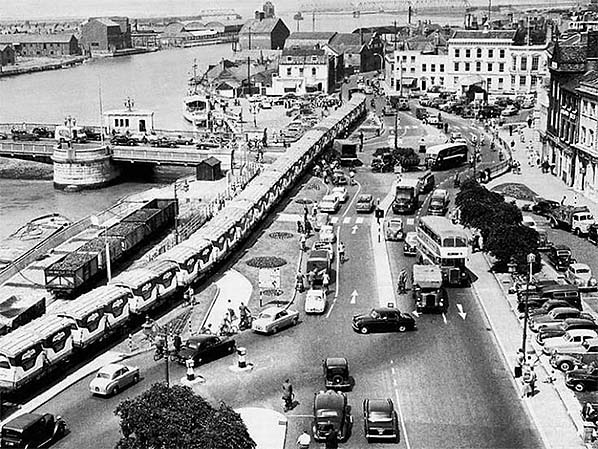 Whilst it was deemed appropriate to provide an simple overview of Yarmouth's fishing industry in the text, unfortunately photographs of fish trains at Yarmouth South Town station - or even on the lines to it - proved frustratingly elusive apart from one or two showing the odd van or container in the background. As a form of compensation this view of the quayside is included instead. Road traffic waiting to cross, or come off, Haven Bridge waits the passing of a train of Birds Eye containers on Conflat wagons to pass. South Town goods and passenger stations are on the opposite side of the river and well out of view here. Another view showing this same scene tells us that there is a diesel shunter at both ends of the train; just out view at bottom left is a BR 20-ton brakevan and a Drewry shunter complete with requisite skirting covering the motion. It is one of those with conical exhaust stack (early examples had a simple pipe) and probably D2210 or D2212, which enables us to date this view to around 1957/58. The Birds Eye train may have come from Beach station but almost certainly from Vauxhall, where the Drewry shunters were outstationed from Norwich around this time. The two shunters mentioned had also spent time at South Town shed but would not have worked from there to the quayside as it became impossible to do so after 1953 when Breydon Viaduct closed. The viaduct is just visible in the far background, disused and with swing span permanently open, it was demolished in the 1960s. Rather nearer the camera an interesting selection of period road vehicles can be seen. The bus nudging around the nearside of what appears to be a Fordson truck belongs to Great Yarmouth Corporation Transport and is probably en-route for South Denes. The bus would appear to be from a batch new in 1947 with Leyland PD1 chassis and Massey 56-seat body, fleet numbers 51 - 60, registration numbers EX 5931 - EX 5940. Whilst it was deemed appropriate to provide an simple overview of Yarmouth's fishing industry in the text, unfortunately photographs of fish trains at Yarmouth South Town station - or even on the lines to it - proved frustratingly elusive apart from one or two showing the odd van or container in the background. As a form of compensation this view of the quayside is included instead. Road traffic waiting to cross, or come off, Haven Bridge waits the passing of a train of Birds Eye containers on Conflat wagons to pass. South Town goods and passenger stations are on the opposite side of the river and well out of view here. Another view showing this same scene tells us that there is a diesel shunter at both ends of the train; just out view at bottom left is a BR 20-ton brakevan and a Drewry shunter complete with requisite skirting covering the motion. It is one of those with conical exhaust stack (early examples had a simple pipe) and probably D2210 or D2212, which enables us to date this view to around 1957/58. The Birds Eye train may have come from Beach station but almost certainly from Vauxhall, where the Drewry shunters were outstationed from Norwich around this time. The two shunters mentioned had also spent time at South Town shed but would not have worked from there to the quayside as it became impossible to do so after 1953 when Breydon Viaduct closed. The viaduct is just visible in the far background, disused and with swing span permanently open, it was demolished in the 1960s. Rather nearer the camera an interesting selection of period road vehicles can be seen. The bus nudging around the nearside of what appears to be a Fordson truck belongs to Great Yarmouth Corporation Transport and is probably en-route for South Denes. The bus would appear to be from a batch new in 1947 with Leyland PD1 chassis and Massey 56-seat body, fleet numbers 51 - 60, registration numbers EX 5931 - EX 5940.
Photo from Jim Lake collection
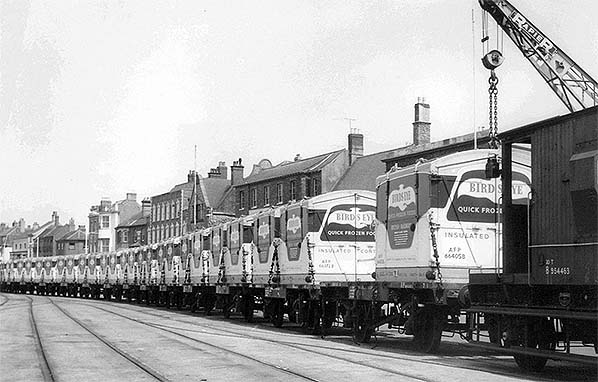 A train of Birds Eye containers on the quayside tramway sometime in the 1950s. Due to the length of the train and the tramway running partly on the street there likely would have been a diesel shunter on each end, one of which would be adjacent to the BR 20t brakevan seen here on the right. Whilst one associates Great Yarmouth with the fishing industry, associating this with these container trains is the easy conclusion but may necessarily be the case. The Birds Eye factory was on South Denes Road and it is likely the containers are loaded with the finished product for distribution across the country, perhaps with cod brought in by rail from elsewhere for processing as Great Yarmouth was still primarily a herring port at this time. This traffic, in or out, could have operated via Vauxhall or Beach but not South Town. It is also possible this and similar photographs were actually publicity shots; the Rapier crane appears to be loading or unloading a container and there being no staff in view might suggest a deliberately posed publicity shot. The AFP code on the containers means A - 7ft 6in long, F - Frozen Food, P - Pallet loading. Confusingly, A type containers were loaded onto 'Conflat B' wagons and usually two per wagon as seen here. The fish wharf is located a little under one mile south of Haven Bridge and opposite the former Barrack Road gasworks. The location of this photograph can be identified as South Quay with, left centre background, the Great Yarmouth Port Authority building and, nearer the camera and with the flagpole, the Port and Haven Commissioners Office both visible and both still A train of Birds Eye containers on the quayside tramway sometime in the 1950s. Due to the length of the train and the tramway running partly on the street there likely would have been a diesel shunter on each end, one of which would be adjacent to the BR 20t brakevan seen here on the right. Whilst one associates Great Yarmouth with the fishing industry, associating this with these container trains is the easy conclusion but may necessarily be the case. The Birds Eye factory was on South Denes Road and it is likely the containers are loaded with the finished product for distribution across the country, perhaps with cod brought in by rail from elsewhere for processing as Great Yarmouth was still primarily a herring port at this time. This traffic, in or out, could have operated via Vauxhall or Beach but not South Town. It is also possible this and similar photographs were actually publicity shots; the Rapier crane appears to be loading or unloading a container and there being no staff in view might suggest a deliberately posed publicity shot. The AFP code on the containers means A - 7ft 6in long, F - Frozen Food, P - Pallet loading. Confusingly, A type containers were loaded onto 'Conflat B' wagons and usually two per wagon as seen here. The fish wharf is located a little under one mile south of Haven Bridge and opposite the former Barrack Road gasworks. The location of this photograph can be identified as South Quay with, left centre background, the Great Yarmouth Port Authority building and, nearer the camera and with the flagpole, the Port and Haven Commissioners Office both visible and both still
standing as of 2017.
Photo from Andrew Barton collection
There was also limited goods-rated fish traffic. The 1.15pm ex-South Town joined at Beccles with the 1.35pm ex-Lowestoft Central and run forward as the 2.10pm to Parkeston. This was a 'Q train' and would not operate if there were less than eight vans. There was an 8.10pm SO ex-Lowestoft Central - Parkeston (Harwich) train which also did not operate if there was less than eight vans. When this situation arose the 1.35pm would operate. When the 8.10pm ran, vans detached at Manningtree would be forwarded at 4.45am to Parkeston; the precise wording being ‘via Parkeston Quay’ which suggests fish were for export. Strange is this may seem it did happen, with Spain being a particularly good market. Another goods-rated train was the 7.35pm ex-South Town which attached wagons at Beccles from the 8.10pm ex-Lowestoft Monday - Friday (as mentioned, this train differed on Saturdays) and ran forward to Bishopsgate.
If all this were not enough, in addition there were several altered and additional workings. Insofar as Yarmouth was concerned the majority of additional and altered workings concerned Yauxhall and Beach stations plus the quayside tramway. One such additional working from South Town was the 1.28pm to Beccles, while one which did not run was the 4.40pm SX South Town - Norwich Thorpe goods. This was another train which by necessity reversed at Haddiscoe but whether via Fleet Junction or Marsh Junction is unclear as the locomotive would require to run round.
As already mentioned, the trains described are mainly concerning South Town and this accounted for a mere fraction of fish sent out from collectively from Yarmouth's three termini. Similarly a mere few of the ultimate destinations for fish, either in wagon loads or in individual boxes, have been listed and the full list covered the entire country although the only mention of Scotland is for trains operating via Ely and Peterborough to ‘East Coast and Scottish Ports’.
Although having nothing to do with South Town directly, fish trains also operated to and from the M&GN and Lowestoft via Breydon Viaduct and Gorleston.
Of course, outgoing wagons and vans loaded with fish also had to return empty and the arrangements for this were even more complex and there are mentions of working via yards, large and small, across the network. One of the smaller yards concerned was Waterbeach (just north of Cambridge) and wagons here were worked from Oxford by the London Midland Region via Trumpington Sidings from where an Eastern Region pilot driver and guard boarded the train. Having dumped wagons at Waterbeach the locomotive returned the short distance to Cambridge light engine while the wagons would be collected and returned to Yarmouth of Lowestoft by later trains. The returning of empties took place seven days per week, day and night. Other wagons were returned via Goodmayes, New Cross Gate, Whitemoor to name just a few.
While all this fishy business was ongoing at Great Yarmouth, Lowestoft's output equalled, if not bettered, that of Great Yarmouth and these two towns were by no means the only ones which kept the railways busy. Lowestoft, incidentally, required extra pilot locomotives, 9am - 5pm, during the fishing season. To ensure everything went to plan - and usually it did - there was a phenomenal amount of communication between stationmasters, regional control centres, London and other major locations, signalmen, train crew and so on concerning locomotive and rolling stock requirements, train formations, loadings, shunting, timetable planning and a host of other things. Today as we roar along in a Sprinter DMU, petrified we may have to face a firing squad owing to not having the right ticket, rarely seeing a signal box or freight train as we catch a glimpse of overgrown remains of the railway system we once had, it is hard to appreciate the complexity of former railway operations. As we look back into the past it is difficult not to hold in high regard the skill and dedication of previous generations of railwaymen who dealt with seasonal traffic in addition to all the regular goods and passenger services. The downside, especially when seasonal traffic was involved, was the labour intensity and the inefficient use of rolling stock. Dr Richard Beeching was quick to recognise this problem and the conveyance of fish by rail ceased in 1964. The exception was small occasional consignments, by the box, by timetabled passenger trains but even this practice did not last much longer. When DMUs were introduced, leaking juices were found to damage flooring in the brake compartment, and complaints about the persistent odour became commonplace.
Increasingly efficient road transport was not the only reason why the railways saw an end to fish traffic. The fishing industry was susceptible to a number of issues, not least politics and economic depressions and Great Yarmouth was no exception. Overfishing is no new thing and has been an issue since the 1950s while European Union fishing quotas, albeit perhaps well intended, drove further nails into the fishing industry's coffin. On that subject it is interesting to note that while the British and German fishing industries are catching less, other nations within the EU have increased their catches.
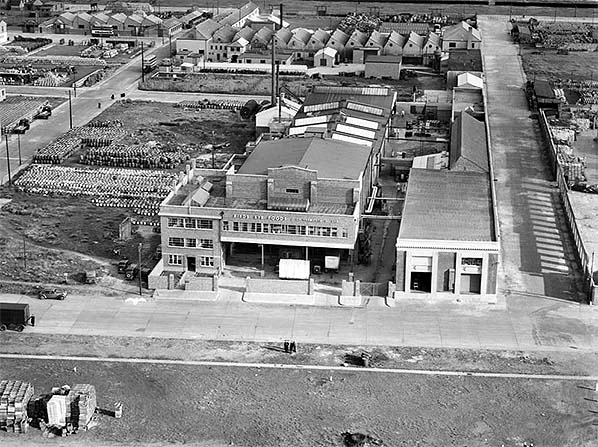 The Birds Eye factory at Great Yarmouth seen here in October 1949, around the time that it opened. The factory was located on South Denes Road, some distance from any of Yarmouth's main railway stations. Visible are what appear to be a couple of insulated containers; these would be taken by road to the railway and dumped onto Conflat wagons for onward transport. Towards top left can be seen a couple of Great Yarmouth Corporation buses. Back in the days when Britain had a manufacturing industry and before people thought one was housebound unless one had a car, or did not feel housebound but could not afford a car, bus operators did good business taking workers to and from factories such as this. Whether Great Yarmouth's buses stank of fish when they got back to the depot is another matter. Today, Birds Eye have ensconced themselves just down the road in Lowestoft. The Birds Eye factory at Great Yarmouth seen here in October 1949, around the time that it opened. The factory was located on South Denes Road, some distance from any of Yarmouth's main railway stations. Visible are what appear to be a couple of insulated containers; these would be taken by road to the railway and dumped onto Conflat wagons for onward transport. Towards top left can be seen a couple of Great Yarmouth Corporation buses. Back in the days when Britain had a manufacturing industry and before people thought one was housebound unless one had a car, or did not feel housebound but could not afford a car, bus operators did good business taking workers to and from factories such as this. Whether Great Yarmouth's buses stank of fish when they got back to the depot is another matter. Today, Birds Eye have ensconced themselves just down the road in Lowestoft.
Photo from Britain From Above with permission
With particular reference to the Great Yarmouth fishing industry, it has been said that the decline was due to the emergence of the fish finger and changing tastes in favour of white fish. Birds Eye had opened a fish processing plant on South Denes Road, Great Yarmouth, in 1945 and from 1955 was engaged in production of the fish finger. Birds Eye claim to have invented the fish finger in 1955 although the product had been around for half a century previously in various forms. The product Clarence Birdseye came up with was the battered, or breaded, product we know today. The Great Yarmouth Mercury recorded that it was female workers at the Yarmouth factory who came up with the name ‘Fish Finger’. The fish finger was originally produced from herring but the Birds Eye settled for cod and in due course haddock fish fingers became available. Due to the presence of Birds Eye in Great Yarmouth, Conflat containers in the distinctive Birds Eye livery became a familiar sight and trains of these vehicles could be seen on the quayside. Much of this traffic went out via Vauxhall but the Birds Eye brand could also be seen at South Town to a lesser extent.
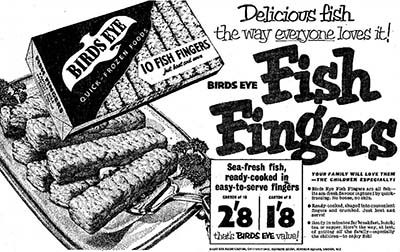 Just how true is the claim that the fish finger and changing tastes were to blame for the demise, over and above overfishing and the EU, of the Yarmouth herring fleet is a matter of opinion. The fish finger is a convenience food requiring no pre-cooking preparation and its popularity may have more to do with an increasing number of housewives going out to work and thus having less time to prepare meals. Takeaway foods such as fish and chips were once an occasional treat for a Friday and perhaps during the evening after a trip to a cinema, as people once did on a regular basis. There is also the question of television; once only an event for a few hours each evening but which with an increasing number of channels and round-the-clock broadcasting has come to almost dominate the home life. This in itself has nudged people towards quick-to-prepare convenience and takeaway foods with fish and chip shops traditionally using white fish. Therefore it could be argued that the demise of the herring fleets is to a large degree the result of changing lifestyles rather than a specific preference for the fish finger and white fish. Television, of course, also exposed people to relentless advertising once ITV hit the airwaves and Birds Eye once advertised its fish fingers, with the help of the semi-fictitious Captain Birds Eye, with almost monotonous regularity. Just how true is the claim that the fish finger and changing tastes were to blame for the demise, over and above overfishing and the EU, of the Yarmouth herring fleet is a matter of opinion. The fish finger is a convenience food requiring no pre-cooking preparation and its popularity may have more to do with an increasing number of housewives going out to work and thus having less time to prepare meals. Takeaway foods such as fish and chips were once an occasional treat for a Friday and perhaps during the evening after a trip to a cinema, as people once did on a regular basis. There is also the question of television; once only an event for a few hours each evening but which with an increasing number of channels and round-the-clock broadcasting has come to almost dominate the home life. This in itself has nudged people towards quick-to-prepare convenience and takeaway foods with fish and chip shops traditionally using white fish. Therefore it could be argued that the demise of the herring fleets is to a large degree the result of changing lifestyles rather than a specific preference for the fish finger and white fish. Television, of course, also exposed people to relentless advertising once ITV hit the airwaves and Birds Eye once advertised its fish fingers, with the help of the semi-fictitious Captain Birds Eye, with almost monotonous regularity.
The last herring drifters had left Great Yarmouth during the 1970s with the remaining fleet catching cod. Great Yarmouth’s last commercial fishing vessel, the 32ft motor vessel Eventide, bowed out in 2010 with her owner laying the blame clearly at the door of the EU. Once Britain has left the EU it remains to be seen if her former industries experience any form of revival. Great Yarmouth's last surviving steam drifter, the Lydia Eva, built at King's Lynn in 1930, can now be seen at South Quay. Restored, she serves as a museum to the town’s once-great fishing industry.
 Home Page Home Page
| Last
updated: Wednesday, 24-May-2017 12:43:39 CEST |
© 1998-2017 Disused Stations
| |


 Home Page
Home Page 

 Home Page
Home Page